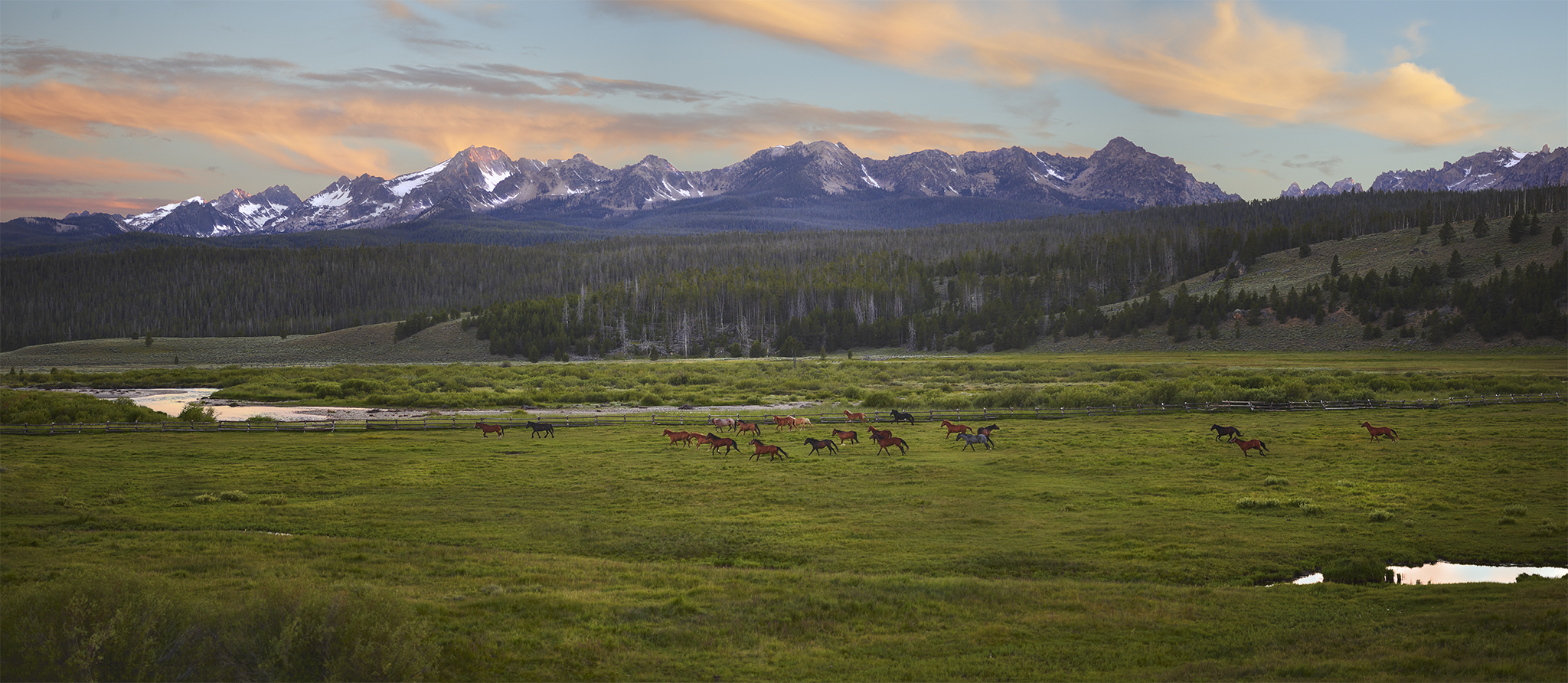
Sunset Serenade in the Sawtooths by Jeffrey H. Lubeck © MESH Art LLC and Claire Porter Photography – courtesy MESH Gallery – all rights reserved.
The 2nd phase of equine photography for MESH Art in 2018 involved photographing horses before and after their workday at the Idaho Rocky Mountain Ranch (IRMR) in Stanley, Idaho. Last winter Kyle and I reached out to Devan Booker at Pioneer Outfitters who runs the guide operations for IRMR to establish if a photo-shoot was in the realm of a possibility. The answer was yes. This spring MESH Art Gallery’s Equine Fine Art Photographer Claire Porter and I established some dates for possible photo-shoots.
A complicating issue is that from June 1st through Labor Day Devan (and his horses) have little if any free time. IRMR is a popular place for people to escape. With help from Devan and his assistant Jenna, Claire and I decided we would photograph the horses before and after their workday. IRMR and Pioneer Outfitters is about as good as it gets with this type of offering. It is a 900 acre ranch that has its operational aspects (e.g., stables, corrals, staff living quarters across the road and on the Salmon River.
Claire and I spent time at the corral talking with Devan and Jenna about the horses and learning what they do in the off hours. We walked the property to establish possible view corridors and sun location. Each day around sunset the horses are released into large open spaces from two different corrals. One group heads north and the other south. Both open spaces have the Salmon River running through the property with a spectacular view of the Sawtooth Mountains. The available land, water, and fresh grasses for the horses is substantial. At sunrise the horses return (on their own or with guidance from Jenna) to the corrals. Claire who has a supreme knowledge, affinity, and connection with horses said to me “expect the unexpected and no matter how well we plan – the opposite is likely to occur.” Truer words have not been spoken! The approximately 50 horses exhibited a variety of behaviors.
As with the Wild Mustang photo-shoot Claire situated herself to be among the horses and I would be situated such that I could capture group and moving shots with the Salmon River and the Sawtooths in the background.

Morning Commute in the Sawtooths by Jeffrey H. Lubeck. © MESH Art LLC and Claire Porter Photography – courtesy of MESH Gallery – all rights reserved.
While the photo-shoot required effort late and early in the day, the location was only about 10-12 minutes from our cabin. So Claire, Linda, and I could have meals and a semblance of normalcy while not shooting.
Jeff”s Worthless Trivia
Decker Peak (10,740) is the big peak in the center of things. It is the third highest peak in the Sawtooth Range. Decker can be summited via the south ridge (Class 3). This route also offers three cool little lakes as you pass 9,000 feet on your way to the summit. To Decker’s south are Red Bluff (10,280), Sevy Peak (10,480), Finger of Fate (9,760), The Arrowhead (10,250), Dave’s (10,579) and Mt. Cramer (10,704). Mt. Cramer is the 2nd highest peak in the Sawtooth’s and can be summited via the east (Class 3). The peaks mentioned in between provide some of the most demanding technical climbing ascents in the region.
My next photo-shoot will be conducted in the peaks of the Mountains displayed above. Starting on Friday July 27th, I along with my long-time teammates Chris and Sarah Lundy (owners of Sawtooth Mountain Guides) will attempt to climb Decker and Cramer and traverse the ridge-lines and peaks in between the two all in a few days time. We hope to get Finger of Fate photographed at dawn and sunset on the same day.
Photographing a fast moving object in low and highly variable light can be a challenge. Seeing I shoot with settings configured manually at all times obtaining an in focus image in usable light requires a great deal of fortune. On this shoot I had both Nikon and PHASE ONE gear by my side. Kyle’s special MESH Photopack bag proved to be a difference maker again. Any and all I wanted or needed was at-the-ready.
Ideally I am capturing landscapes in well orchestrated conditions and lighting. While travel to this kind of photo location often involves multiple days and a highly demanding ascent with heavy gear on my back, I usually arrive hours before the shoot and have time for preparation and establishing the desired composition. The implication is I can be picky and demanding (tripod, ISO 50, 1/250th – 1/320th second, and at F2 to F11).
As for photo-shoots of horses… bye-bye landscape methodology. Except for focus, manual configuration remains in place for me. However, the camera gear and my ability to manipulate it are put to the test. The Sunset Serenade shot was captured by the PHASE ONE (think heavy gear), ISO 1600, 1/2000th of a second and at F2.8.